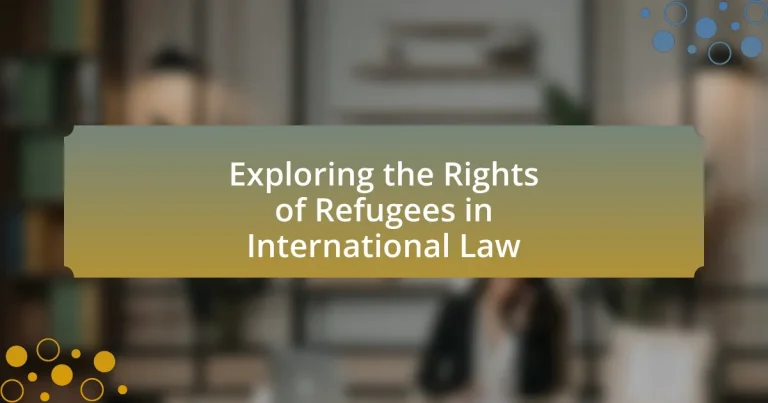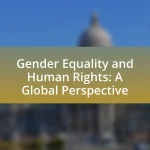The article focuses on the rights of refugees as defined by international law, primarily through the 1951 Refugee Convention and its 1967 Protocol. It outlines fundamental rights such as the right to seek asylum, non-refoulement, protection from discrimination, and access to basic services. The article also discusses the criteria for refugee classification, the obligations of states towards refugees, and the role of regional frameworks in complementing international protections. Additionally, it addresses contemporary challenges, including nationalism, economic factors, and the impact of climate change on refugee rights, while highlighting best practices and the importance of international cooperation and NGO advocacy in enhancing refugee protections.
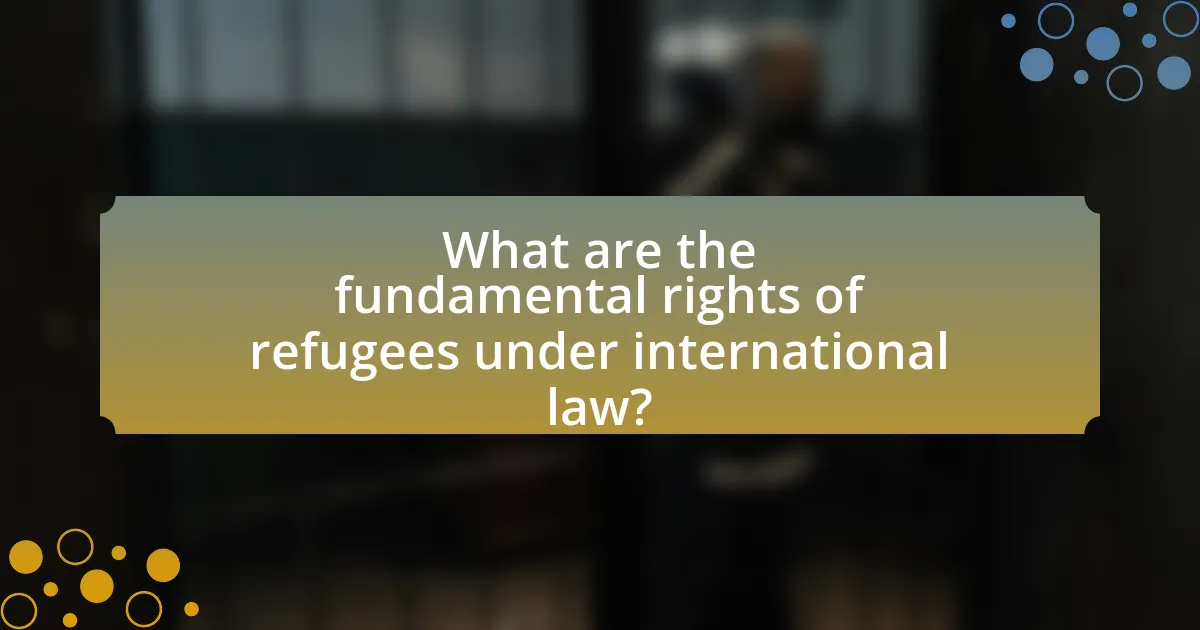
What are the fundamental rights of refugees under international law?
The fundamental rights of refugees under international law include the right to seek asylum, the right to non-refoulement, the right to protection from discrimination, and the right to access basic services. The 1951 Refugee Convention and its 1967 Protocol outline these rights, emphasizing that refugees should not be returned to a country where they face serious threats to their life or freedom. Additionally, refugees are entitled to legal assistance, education, and employment opportunities, ensuring their dignity and integration into host societies. These rights are supported by various international human rights instruments, reinforcing the obligation of states to uphold them.
How is the term ‘refugee’ defined in international law?
The term ‘refugee’ is defined in international law by the 1951 Refugee Convention and its 1967 Protocol, which state that a refugee is an individual who is outside their country of nationality and has a well-founded fear of persecution due to race, religion, nationality, membership in a particular social group, or political opinion. This definition establishes the criteria for determining who qualifies for refugee status and the protections afforded to them under international law. The Convention outlines the rights of refugees and the obligations of states to protect them, reinforcing the legal framework for refugee protection globally.
What criteria must individuals meet to be classified as refugees?
Individuals must meet specific criteria to be classified as refugees, primarily defined by the 1951 Refugee Convention. These criteria include having a well-founded fear of persecution due to race, religion, nationality, membership in a particular social group, or political opinion. This definition is supported by international law, which mandates that individuals must be outside their country of nationality and unable or unwilling to return due to such fear. The United Nations High Commissioner for Refugees (UNHCR) emphasizes that the fear of persecution must be credible and that the individual must not be able to seek protection from their home country.
How do different international agreements define refugees?
Different international agreements define refugees primarily through the 1951 Refugee Convention and its 1967 Protocol, which establish that a refugee is someone who has a well-founded fear of persecution due to race, religion, nationality, membership in a particular social group, or political opinion. The Convention outlines the rights of refugees and the legal obligations of states to protect them. Additionally, the Organization of African Unity’s 1969 Convention Governing the Specific Aspects of Refugee Problems in Africa expands the definition to include individuals fleeing external aggression, occupation, foreign domination, or events seriously disturbing public order. These definitions are crucial for establishing the legal framework for refugee protection and the responsibilities of nations under international law.
What are the key international legal instruments protecting refugee rights?
The key international legal instruments protecting refugee rights include the 1951 Refugee Convention and its 1967 Protocol, which establish the definition of a refugee and outline the rights of individuals granted asylum. These instruments obligate signatory states to provide protection and ensure non-refoulement, meaning refugees cannot be returned to a country where they face serious threats to their life or freedom. Additionally, the 1984 Convention Against Torture and Other Cruel, Inhuman or Degrading Treatment or Punishment reinforces the principle of non-refoulement, further safeguarding the rights of refugees.
What role does the 1951 Refugee Convention play in refugee rights?
The 1951 Refugee Convention establishes the legal framework for the protection of refugees and their rights. It defines who qualifies as a refugee, outlines the obligations of states to protect them, and prohibits their expulsion or return to places where they face serious threats to their life or freedom. The Convention also emphasizes the right to seek asylum and the principle of non-refoulement, which is critical in safeguarding refugees from persecution. These provisions are foundational in international law, ensuring that refugees receive essential rights and protections, thereby shaping national policies and practices regarding refugee treatment globally.
How does the 1967 Protocol expand the protections for refugees?
The 1967 Protocol expands the protections for refugees by removing the temporal and geographic limitations imposed by the 1951 Refugee Convention. This Protocol broadens the definition of a refugee to include individuals fleeing persecution due to various factors, such as race, religion, nationality, membership in a particular social group, or political opinion, without restricting it to events occurring before January 1, 1951, or to Europe. The Protocol’s adoption by the United Nations General Assembly in 1967 reflects a commitment to addressing the needs of refugees globally, thereby enhancing their legal status and access to rights and protections under international law.
What obligations do states have towards refugees under international law?
States have a legal obligation to protect refugees under international law, primarily through the 1951 Refugee Convention and its 1967 Protocol. These obligations include the principle of non-refoulement, which prohibits states from returning refugees to countries where they face serious threats to their life or freedom. Additionally, states must provide refugees with access to asylum procedures, ensure their basic rights such as access to education and healthcare, and facilitate their integration into society. The United Nations High Commissioner for Refugees (UNHCR) emphasizes that these obligations are essential for safeguarding the rights and dignity of refugees, reflecting the commitment of the international community to uphold human rights standards.
How do non-refoulement principles protect refugees?
Non-refoulement principles protect refugees by prohibiting the return of individuals to countries where they face serious threats to their life or freedom. This legal obligation, enshrined in international treaties such as the 1951 Refugee Convention, ensures that refugees cannot be forcibly returned to places where they risk persecution, torture, or inhumane treatment. The principle is supported by various human rights instruments, including the Convention Against Torture, which reinforces the obligation not to return individuals to situations where they may be subjected to torture or cruel, inhuman, or degrading treatment.
What rights do refugees have regarding asylum procedures?
Refugees have the right to seek asylum and to have their claims assessed fairly and efficiently. This right is enshrined in the 1951 Refugee Convention and its 1967 Protocol, which obligate states to provide access to asylum procedures and to ensure that refugees are not returned to countries where they face serious threats to their life or freedom. Additionally, refugees are entitled to legal assistance during the asylum process, the right to appeal decisions, and protection from discrimination based on race, religion, or nationality. These rights are crucial for ensuring that refugees can effectively navigate the asylum system and receive the protection they need.
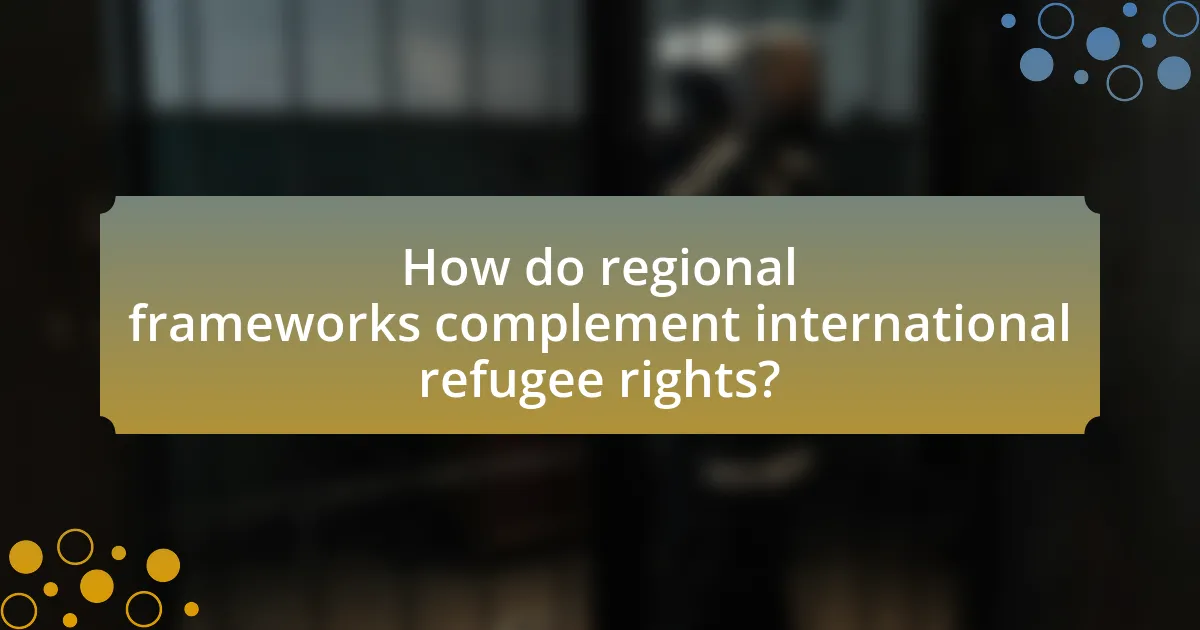
How do regional frameworks complement international refugee rights?
Regional frameworks complement international refugee rights by providing tailored protections and mechanisms that address specific regional challenges and contexts. For instance, the 1969 OAU Refugee Convention in Africa expands the definition of a refugee to include those fleeing generalized violence, thereby addressing unique regional conflicts. Similarly, the Cartagena Declaration in Latin America emphasizes the need for protection in situations of internal conflict and human rights violations, reflecting the region’s specific circumstances. These frameworks enhance the implementation of international standards by adapting them to local realities, thus ensuring more effective protection for refugees in diverse environments.
What are the main regional agreements addressing refugee rights?
The main regional agreements addressing refugee rights include the 1969 Organization of African Unity (OAU) Refugee Convention, the 1984 Cartagena Declaration on Refugees, and the 2004 African Union (AU) Convention for the Protection and Assistance of Internally Displaced Persons in Africa. The OAU Refugee Convention expands the definition of a refugee to include those fleeing events seriously disturbing public order, while the Cartagena Declaration emphasizes the need for protection for individuals fleeing generalized violence and human rights violations. The AU Convention builds on these frameworks by addressing the protection of internally displaced persons, highlighting the interconnectedness of refugee and displacement issues in Africa.
How does the African Union’s Refugee Convention differ from the 1951 Convention?
The African Union’s Refugee Convention differs from the 1951 Convention primarily in its broader definition of a refugee. The African Union’s Convention, adopted in 1969, includes individuals fleeing events that seriously disrupt public order, such as armed conflict and generalized violence, whereas the 1951 Convention focuses on individuals fleeing persecution based on specific grounds like race, religion, nationality, membership in a particular social group, or political opinion. This expanded definition reflects the unique challenges faced by African nations, where conflicts often lead to mass displacement. Additionally, the African Union’s Convention emphasizes the importance of regional cooperation and the responsibility of member states to protect refugees, which is less pronounced in the 1951 Convention.
What protections does the European Union provide for refugees?
The European Union provides several protections for refugees, primarily through the Common European Asylum System (CEAS). This system establishes standards for the treatment of asylum seekers, ensuring their right to seek international protection and access to fair and efficient asylum procedures.
Under CEAS, refugees are entitled to non-refoulement, meaning they cannot be returned to a country where they face serious threats to their life or freedom. Additionally, the EU’s Reception Conditions Directive mandates that refugees receive adequate housing, food, and healthcare during the asylum process. The Qualification Directive further defines who qualifies for international protection and the rights associated with it, including access to education and employment.
These protections are reinforced by the Charter of Fundamental Rights of the European Union, which guarantees the right to asylum and upholds the principle of human dignity.
How do regional practices impact the implementation of refugee rights?
Regional practices significantly influence the implementation of refugee rights by shaping legal frameworks, policies, and the overall treatment of refugees. For instance, the 1951 Refugee Convention and its 1967 Protocol provide a universal standard for refugee rights, but regional agreements, such as the African Union’s 1969 Refugee Convention and the Cartagena Declaration in Latin America, introduce specific provisions that reflect local contexts and challenges. These regional frameworks can enhance or restrict rights based on political, social, and economic factors unique to each area. For example, in regions with high levels of conflict or economic instability, such as the Middle East, countries may adopt more restrictive measures, impacting refugees’ access to asylum and basic rights. Conversely, regions with robust human rights protections may offer more comprehensive support and integration opportunities for refugees, demonstrating how local practices directly affect the realization of refugee rights.
What challenges do countries face in upholding refugee rights regionally?
Countries face significant challenges in upholding refugee rights regionally, primarily due to political instability, economic constraints, and varying legal frameworks. Political instability in regions experiencing conflict often leads to a lack of resources and infrastructure necessary for supporting refugees, as seen in countries like Syria and Afghanistan, where ongoing violence hampers the implementation of refugee protections. Economic constraints further complicate the situation, as many host countries struggle with limited financial resources, making it difficult to provide adequate services and support for refugees. Additionally, varying legal frameworks across countries create inconsistencies in the protection of refugee rights, as some nations may not fully adhere to international treaties such as the 1951 Refugee Convention, leading to disparities in treatment and access to rights for refugees.
How do regional conflicts influence refugee protection mechanisms?
Regional conflicts significantly influence refugee protection mechanisms by creating urgent humanitarian crises that necessitate immediate international response and legal frameworks. For instance, conflicts in Syria and Afghanistan have led to millions of displaced individuals, prompting countries and organizations to adapt their policies to accommodate the influx of refugees. The 1951 Refugee Convention and its 1967 Protocol serve as foundational legal instruments, but regional conflicts often expose gaps in these frameworks, leading to the establishment of temporary protection measures and regional agreements, such as the EU’s Temporary Protection Directive during the Syrian crisis. These adaptations reflect the need for flexible and responsive protection mechanisms that can address the unique challenges posed by specific conflicts, thereby ensuring that refugees receive adequate support and legal recognition in host countries.
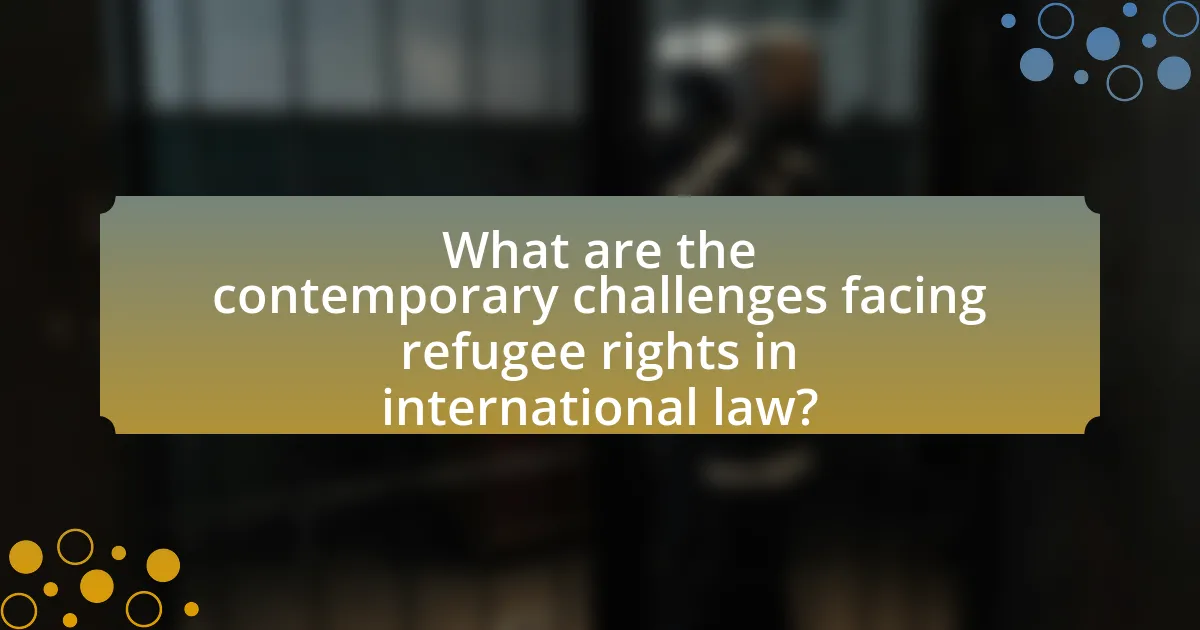
What are the contemporary challenges facing refugee rights in international law?
Contemporary challenges facing refugee rights in international law include the rise of nationalism, restrictive immigration policies, and the inadequacy of existing legal frameworks to address the complexities of modern displacement. Nationalism has led to increased hostility towards refugees, resulting in policies that limit their access to asylum and basic rights. For instance, countries like Hungary and Poland have implemented laws that effectively close borders to asylum seekers. Additionally, the 1951 Refugee Convention and its 1967 Protocol, while foundational, do not adequately cover the needs of refugees fleeing climate change or internal conflicts, leaving many without protection. The UNHCR reported that in 2021, over 26 million refugees were under its mandate, highlighting the urgent need for updated legal protections that reflect current global realities.
How do political climates affect the enforcement of refugee rights?
Political climates significantly influence the enforcement of refugee rights by shaping government policies and public attitudes towards refugees. In countries with supportive political environments, laws and practices tend to align with international human rights standards, facilitating the protection and integration of refugees. For instance, during the Syrian refugee crisis, nations like Germany adopted welcoming policies, allowing over a million refugees to seek asylum, reflecting a political climate that prioritized humanitarian response. Conversely, in politically hostile climates, such as Hungary’s approach during the same crisis, restrictive measures were implemented, including border closures and detention policies, undermining refugee rights. These contrasting examples illustrate how political will and public sentiment directly impact the legal and practical enforcement of refugee protections.
What role does nationalism play in shaping refugee policies?
Nationalism significantly influences the formulation of refugee policies by prioritizing the interests and identity of the nation-state over humanitarian considerations. Nationalist sentiments often lead to restrictive immigration laws, as countries may perceive refugees as a threat to cultural homogeneity or economic stability. For instance, during the Syrian refugee crisis, countries like Hungary implemented strict border controls and limited asylum applications, citing national security and cultural preservation as justifications. This trend reflects a broader pattern where nationalist ideologies shape public opinion and political discourse, resulting in policies that can undermine the rights of refugees as outlined in international law.
How do economic factors influence state obligations towards refugees?
Economic factors significantly influence state obligations towards refugees by determining the resources available for their support and integration. States with stronger economies are generally better positioned to fulfill their obligations under international law, such as the 1951 Refugee Convention, which mandates the provision of basic needs and protection. For instance, countries like Germany, which has a robust economy, have been able to implement comprehensive refugee programs, providing housing, education, and employment opportunities. Conversely, nations facing economic challenges may struggle to meet these obligations, leading to inadequate support for refugees. This disparity is evident in the response to the Syrian refugee crisis, where wealthier nations have taken in a larger share of refugees compared to economically strained countries, highlighting how economic capacity directly impacts the fulfillment of state obligations.
What are the implications of climate change on refugee rights?
Climate change significantly impacts refugee rights by increasing the number of individuals displaced due to environmental factors such as extreme weather events, sea-level rise, and resource scarcity. The United Nations High Commissioner for Refugees (UNHCR) estimates that by 2050, climate change could displace over 200 million people globally. This displacement challenges existing legal frameworks, as current international laws do not explicitly recognize climate refugees, leaving them without adequate protection or rights. Consequently, the lack of legal recognition can hinder access to asylum, humanitarian aid, and basic services for those affected by climate-induced displacement.
How is the definition of refugees evolving to include climate migrants?
The definition of refugees is evolving to include climate migrants by recognizing that individuals displaced due to climate change-related events, such as extreme weather, sea-level rise, and environmental degradation, face similar vulnerabilities as traditional refugees. This evolution is reflected in discussions at international forums, such as the United Nations Framework Convention on Climate Change, where the need for legal frameworks to protect climate migrants is increasingly acknowledged. For instance, the 2018 Global Compact for Safe, Orderly and Regular Migration emphasizes the importance of addressing the needs of those displaced by climate impacts, indicating a shift towards broader interpretations of refugee status that encompass environmental factors.
What legal protections exist for environmentally displaced persons?
Legal protections for environmentally displaced persons are limited and primarily derived from existing international frameworks, such as the United Nations Framework Convention on Climate Change and the Paris Agreement, which recognize the need for adaptation and support for affected populations. However, these frameworks do not explicitly define or provide comprehensive rights for environmentally displaced individuals. The 2018 Global Compact for Safe, Orderly and Regular Migration acknowledges the challenges faced by such individuals and encourages states to develop policies that address their needs, yet it lacks binding legal obligations. Additionally, some regional instruments, like the African Union’s Kampala Convention, offer more specific protections for internally displaced persons due to environmental factors. Overall, while there are some legal frameworks addressing the issue, the protections for environmentally displaced persons remain insufficient and fragmented.
What best practices can enhance the protection of refugee rights?
Best practices that can enhance the protection of refugee rights include the implementation of comprehensive legal frameworks, access to fair asylum procedures, and the promotion of social integration initiatives. Comprehensive legal frameworks, such as the 1951 Refugee Convention and its 1967 Protocol, establish clear guidelines for the treatment and rights of refugees, ensuring their protection under international law. Access to fair asylum procedures is crucial, as it allows refugees to present their claims without discrimination, supported by organizations like UNHCR, which advocates for the right to seek asylum. Additionally, social integration initiatives, including language and vocational training, foster community acceptance and economic self-sufficiency, which are essential for the long-term well-being of refugees. These practices collectively contribute to a more robust protection of refugee rights, as evidenced by successful case studies in countries that have adopted such measures.
How can international cooperation improve refugee rights enforcement?
International cooperation can improve refugee rights enforcement by establishing standardized legal frameworks and collaborative mechanisms among nations. When countries work together, they can create binding agreements, such as the 1951 Refugee Convention, which sets out the rights of refugees and the responsibilities of states to protect them. This cooperation facilitates information sharing, resource allocation, and joint initiatives that enhance the capacity of individual nations to uphold refugee rights. For instance, the European Union’s Common European Asylum System aims to harmonize asylum procedures across member states, ensuring that refugees receive consistent protection and support. Such collaborative efforts lead to more effective monitoring and accountability, ultimately strengthening the enforcement of refugee rights on a global scale.
What role do NGOs play in advocating for refugee rights?
NGOs play a crucial role in advocating for refugee rights by providing legal assistance, raising awareness, and influencing policy changes. These organizations often work directly with refugees to ensure they understand their rights and access necessary services, such as legal representation and healthcare. For instance, NGOs like the International Rescue Committee and Refugees International actively engage in lobbying governments and international bodies to uphold and strengthen refugee protections under international law, including the 1951 Refugee Convention. Their efforts have led to significant policy reforms and increased funding for refugee programs, demonstrating their impact on improving the lives of displaced individuals.
